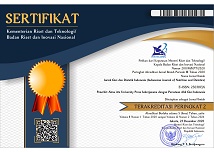Expanding the role of mobile apps in preventing hyperphosphatemia in patients undergoing haemodialysis: A systematic review and meta-analysis
Abstract
Background: Improper diets of patients with chronic kidney disease undergoing hemodialysis are likely to develop hyperphosphatemia, which can also result in other complications such as lacking of calcium and protein. Meanwhile, dietary management using Mobile Apps can provide specific diet programs for every patient to control nutrition.
Objectives: This review aims to identify the effectiveness of Mobile App based self-management dietary program to control phosphate, calcium, and albumin level for patients with hemodialysis.
Methods: This systematic review and meta-analysis follows PRISMA (Preferred Reporting Items for Systematic and Meta-Analysis) Guideline. Study selection was done using several electronic databases such as PubMed, Cochrane Library, ScienceDirect, Springer, EBSCO, EMBASE, Google Scholar, Proquest, SAGE, Taylor & Francis, and SCOPUS. Bias risk was analyzed with Cochrane Risk of Bias 2.0 Tool, then meta-analysis was made using Review Manager V5.4.
Results:This study included 5 randomized controlled studies that were later interpreted with meta-analysis. Based on the result, there are significant effect for phosphate level reduction (pooled MD -0.63, 95% CI [-1.18,-0.08], p=0.02, I2=82%) and calcium level increase (pooled MD=-0.51, 95% CI [-0.77,-0.24], p=0.0002, I2=0%). Meanwhile, there is no significant change in albumin level (pooled MD=-0.09, 95% CI [-0.33,0.16], p=0.49, I2=0%).
Conclusions: In conclusion, mobile App based self-management diet significantly reduces phosphate level and is likely to maintain albumin level for hemodialysis patients. This intervention also has the potential to increase calcium levels to prevent bone disease.
Keywords
Full Text:
PDFReferences
Karam S, Amouzegar A, Alshamsi IR, Al Ghamdi SMG, Anwar S, Ghnaimat M, et al. Capacity for the management of kidney failure in the International Society of Nephrology Middle East region: report from the 2023 ISN Global Kidney Health Atlas (ISN-GKHA). Kidney International Supplements. 2024;13(1):57–70.
Ismail I, . M, . H. Nilai Ureum, Kreatinin, Dan Penyingkiran Kreatinin Di Penderita Penyakit Ginjal Menahun (Kronik). Indonesian Journal of Clinical Pathology and Medical Laboratory. 2018;13(3):100–3.
Yauri LF, Moeis ES, Pandelaki K. Gambaran hasil produk kalsium dan fosfor pada pasien penyakit ginjal kronik stadium V di Ruang Hemodialisis RSUP Prof. Dr. R. D. Kandou Manado. e-CliniC. 2016;4(2):2–7.
Goodman WG, Belin TR, Salusky IB. In vivo assessments of calcium-regulated parathyroid hormone release in secondary hyperparathyroidism. Kidney International Journal. 1996;50(6):1834–44.
Moon H, Chin HJ, Na KY, Joo KW, Kim YS, Kim S, et al. Hyperphosphatemia and risks of acute kidney injury, end-stage renal disease, and mortality in hospitalized patients. BMC Nephrology. 2019;20(1):1–7.
Raikou VD. Serum phosphate and chronic kidney and cardiovascular disease: Phosphorus potential implications in general population. World Journal of Nephrology. 2021;10(5):76–87.
Nadkarni GN, Uribarri J. Phosphorus and the kidney: What is known and what is needed. Advances in Nutrition. 2014;5(1):98–103.
Achinger SG, Ayus JC. The role of daily dialysis in the control of hyperphosphatemia. Kidney International Supplements. 2005;67(95):28–32.
Syauqy A, . S, . S. Asupan protein dan fosfor, rasio fosfor-protein, dan kadar fosfor darah pada pasien gagal ginjal kronis dengan hemodialisis. Jurnal Gizi Klinik Indonesia. 2012;9(2):58.
Yin J, Yin J, Lian R, Li P, Zheng J. Implementation and effectiveness of an intensive education program on phosphate control among hemodialysis patients: a non-randomized, single-arm, single-center trial. BMC Nephrology. 2021;22(1):1–10.
Chiang YC, Chang YP, Lin SC, Lin C, Hsu PH, Hsu YJ, et al. Effects of Individualized Dietary Phosphate Control Program With a Smartphone Application in Hemodialysis Patients in Taiwan. Biological Research For Nursing. 2021;23(3):375–81.
Kawate Y, Miyata H. The importance of nutritional intervention by dietitians for hyperphosphatemia in maintained hemodialysis patients. Renal Replacement Therapy. 2017;3(1):1–13.
Scott IA, Scuffham P, Gupta D, Harch TM, Borchi J, Richards B. Going digital: A narrative overview of the effects, quality and utility of mobile apps in chronic disease self-management. Australian Health Review. 2019;44(1):62–82.
Teong LF, Khor BH, Purba KR, Gafor AHA, Goh BL, Bee BC, et al. A Mobile App for Triangulating Strategies in Phosphate Education Targeting Patients with Chronic Kidney Disease in Malaysia: Development, Validation, and Patient Acceptance. Healthcare. 2022;10(3).
Min Y, Park M. Effects of a Mobile-App-Based Self-Management Support Program For Elderly Hemodialysis Patients. 2020;26(2):93–103.
Huang N, Li H, Fan L, Zhou Q, Fu D, Guo L, et al. Serum Phosphorus and Albumin in Patients Undergoing Peritoneal Dialysis: Interaction and Association With Mortality. Frontiers in Medicine. 2021;8(December):1–10.
Rahmawati F. Aspek Laboratorium Gagal Ginjal Kronik. Jurnal Ilmu Kedokteran Wijaya Kusuma. 2018;6(1):14.
Shinaberger CS, Greenland S, Kopple JD, Van Wyck D, Mehrotra R, Kovesdy CP, et al. Is controlling phosphorus by decreasing dietary protein intake beneficial or harmful in persons with chronic kidney disease? The American Journal of Clinical Nutrition [Internet]. 2008;88(6):1511–8. Available from: https://doi.org/10.3945/ajcn.2008.26665
González-Parra E, Gracia-Iguacel C, Egido J, Ortiz A. Phosphorus and nutrition in chronic kidney disease. International Journal Nephrology. 2012;2012.
Ruospo M, Palmer SC, Natale P, Craig JC, Vecchio M, Elder GJ, et al. Phosphate binders for preventing and treating chronic kidney disease-mineral and bone disorder (CKD-MBD). Cochrane Database Systematic Review. 2018;2018(8).
Susanti E, Wulandari A. Hubungan Kadar Kalsium Dan Fosfor Darah Pada Penderita Penyakit Ginjal Kronik (PGK) Di Rumah Sakit Gading Pluit Jakarta Utara. Anakes Jurnal Ilmu Analisis Kesehatan. 2019;5(1):43–52.
Pack S, Lee J. Randomised controlled trial of a smartphone application-based dietary self-management program on haemodialysis patients. Journal of Clinical Nursing. 2021;30(5–6):840–8.
Farfan-Ruiz AC, Czikk D, Leidecker J, Ramsay T, Mccormick B, Wilson K, et al. Multidisciplinary Team versus a “Phosphate-Counting”App for Serum Phosphate Control: A Randomized Controlled Trial. Kidney360. 2021;2(2):290–7.
St-Jules DE, Woolf K, Goldfarb DS, Pompeii M Lou, Li H, Wang C, et al. Feasibility and Acceptability of mHealth Interventions for Managing Hyperphosphatemia in Patients Undergoing Hemodialysis. Journal of Renal Nutrition [Internet]. 2021;31(4):403–10. Available from: https://doi.org/10.1053/j.jrn.2020.07.009
Khor SM, Chong CP. Effectiveness of self-adjusted phosphate binder dose according to dietary phosphate content method in improving hyperphosphatemia among hemodialysis patients. Eastern Journal of Medicine. 2020;25(2):202–10.
DOI: http://dx.doi.org/10.21927/ijnd.2024.12(5).319-329
Refbacks
- There are currently no refbacks.

This work is licensed under a Creative Commons Attribution-ShareAlike 4.0 International License.
Indonesian Journal of Nutrition and Dietetics (IJND) indexed by:
 View My Stats
View My Stats



12.png)


























